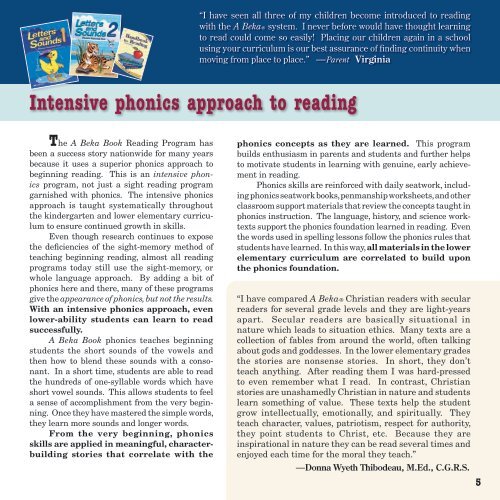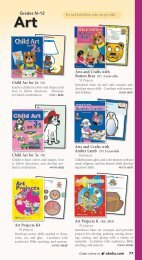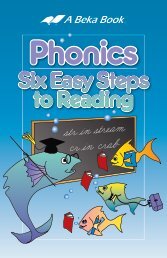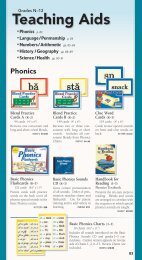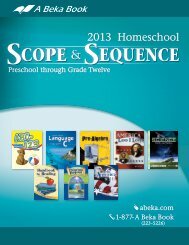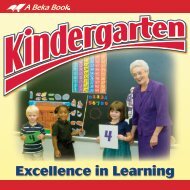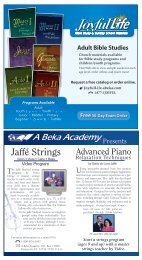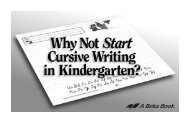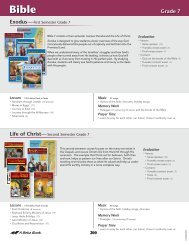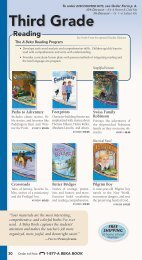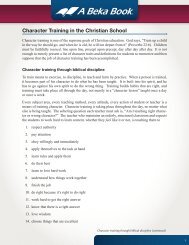A Beka Book Reading Brochure 10 Web, low
A Beka Book Reading Brochure 10 Web, low
A Beka Book Reading Brochure 10 Web, low
- No tags were found...
Create successful ePaper yourself
Turn your PDF publications into a flip-book with our unique Google optimized e-Paper software.
“I have seen all three of my children become introduced to readingwith the A <strong>Beka</strong>R system. I never before would have thought learningto read could come so easily! Placing our children again in a schoolusing your curriculum is our best assurance of finding continuity whenmoving from place to place.” —Parent VirginiaIntensive phonics approach to readingThe A <strong>Beka</strong> <strong>Book</strong> <strong>Reading</strong> Program hasbeen a success story nationwide for many yearsbecause it uses a superior phonics approach tobeginning reading. This is an intensive phonicsprogram, not just a sight reading programgarnished with phonics. The intensive phonicsapproach is taught systematically throughoutthe kindergarten and <strong>low</strong>er elementary curriculumto ensure continued growth in skills.Even though research continues to exposethe deficiencies of the sight-memory method ofteaching beginning reading, almost all readingprograms today still use the sight-memory, orwhole language approach. By adding a bit ofphonics here and there, many of these programsgive the appearance of phonics, but not the results.With an intensive phonics approach, even<strong>low</strong>er-ability students can learn to readsuccessfully.A <strong>Beka</strong> <strong>Book</strong> phonics teaches beginningstudents the short sounds of the vowels andthen how to blend these sounds with a consonant.In a short time, students are able to readthe hundreds of one-syllable words which haveshort vowel sounds. This al<strong>low</strong>s students to feela sense of accomplishment from the very beginning.Once they have mastered the simple words,they learn more sounds and longer words.From the very beginning, phonicsskills are applied in meaningful, characterbuildingstories that correlate with thephon ics concepts as they are learned. This programbuilds enthusiasm in parents and students and further helpsto motivate students in learning with genuine, early achievementin reading.Phonics skills are reinforced with daily seatwork, includingphonics seatwork books, penmanship worksheets, and otherclassroom support materials that review the concepts taught inphonics instruction. The language, history, and science worktextssupport the phonics foundation learned in reading. Eventhe words used in spelling lessons fol<strong>low</strong> the phonics rules thatstudents have learned. In this way, all materials in the <strong>low</strong>erelementary curriculum are correlated to build uponthe phonics foundation.“I have compared A <strong>Beka</strong> ® Christian readers with secularreaders for several grade levels and they are light-yearsapart. Secular readers are basically situational innature which leads to situation ethics. Many texts are acollection of fables from around the world, often talkingabout gods and goddesses. In the <strong>low</strong>er elementary gradesthe stories are nonsense stories. In short, they don’tteach anything. After reading them I was hard-pressedto even remember what I read. In contrast, Christianstories are unashamedly Christian in nature and studentslearn something of value. These texts help the studentgrow intellectually, emotionally, and spiritually. Theyteach character, values, patriotism, respect for authority,they point students to Christ, etc. Because they areinspirational in nature they can be read several times andenjoyed each time for the moral they teach.”—Donna Wyeth Thibodeau, M.Ed., C.G.R.S.5


